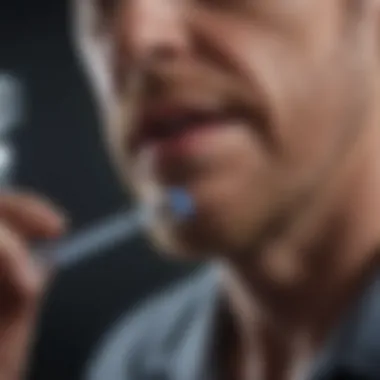Erectile Dysfunction Treatment: Injection Options Explained


Intro
Erectile dysfunction (ED) is a condition that affects a significant number of men worldwide. It can have profound implications on quality of life, including psychological effects and relational dynamics. While various treatment options exist, injection therapy has gained attention for its effectiveness in managing ED. This article aims to shed light on injection-based treatments, discussing their mechanisms, safety profiles, and overall place in ED management.
Injections can offer direct solutions for men who struggle with erection difficulties. Unlike oral medications, which rely on systemic absorption, injectable treatments bypass initial metabolic processes, often resulting in faster action. However, it is crucial to understand both the benefits and risks associated with these methods.
The examination of injection therapy provides valuable insights for patients, healthcare professionals, and researchers alike. By evaluating current evidence and understanding patient experiences, this discussion aims to broaden the reader's perspective on ED treatments.
Understanding Erectile Dysfunction
Understanding erectile dysfunction (ED) is vital to addressing its treatment. This section delves into the definition, prevalence, and causes of ED, establishing a clear foundation for exploring injection therapies in later sections.
The significance of comprehending ED lies in its broad implications on physical health and mental well-being. By grasping how ED affects a significant portion of the male population, we can appreciate the urgency for effective therapies. Moreover, recognizing the complex causes behind ED—ranging from physical ailments to psychological factors—can empower individuals and couples to seek appropriate help.
ED is more than just a medical concern; it can impact relationships and emotional health. In this article, we aim to cover the various aspects of ED, emphasizing the importance of understanding this condition before jumping into specific treatment options.
Definition and Prevalence
Erectile dysfunction is defined as the inability to achieve or maintain an erection sufficient for satisfactory sexual performance. The World Health Organization estimates that about 150 million men worldwide suffer from ED. This prevalence highlights not only the commonality of the condition but also the urgent need for viable treatment options.
Causes of Erectile Dysfunction
Erectile dysfunction can arise from various sources, each contributing differently to the condition. Understanding these causes is essential for identifying the right treatment options.
Physical Causes
Physical causes of ED include medical conditions such as diabetes, heart disease, and hypertension. These health issues can lead to complications that impede blood flow and nerve function necessary for an erection. The key characteristic of physical causes is their often identifiable link to specific health conditions, making them a subject of medical evaluation.
Recognizing physical causes is beneficial in this article as it aids in determining further treatment options. For example, when a patient suffers from diabetes, addressing the blood sugar levels may improve erectile function. However, these causes have the disadvantage of requiring intensive management of underlying conditions, which can take time and patience.
Psychological Causes
Psychological causes encompass mental health issues such as anxiety, depression, and stress, which can have a profound impact on sexual performance. The central aspect of psychological causes is that they often aren't related to physical health, meaning that even men in good health can experience ED due to mental burdens.
This topic is relevant to our article because addressing psychological causes demands a different approach. This might include therapy or counseling to alleviate anxiety, which can improve symptoms of ED. The challenge lies in the subjective nature of psychological health, which can make treatment complex and less predictable than treating physical ailments.
Lifestyle Factors
Lifestyle factors such as smoking, alcohol use, obesity, and lack of physical activity contribute significantly to the onset of ED. A notable characteristic of lifestyle factors is that they can often be modified. Changing habits, such as adopting a healthier diet or quitting smoking, can lead to improvements in erectile function.
Highlighting these factors as part of this article is vital since they provide actionable steps that individuals can take. The unique feature of lifestyle factors is their potential reversibility; improving one’s lifestyle can yield considerable benefits over time. However, the effectiveness of these changes can vary greatly between individuals, sometimes leading to disappointment if immediate results are not seen.
Understanding the various dimensions of erectile dysfunction serves as an important step toward finding suitable treatment solutions, including injectable therapies. By looking into the physical, psychological, and lifestyle-related causes, one can better navigate the path to reclaiming sexual health.
Overview of ED Treatment Options
Erectile dysfunction (ED) represents a significant health concern that affects countless individuals worldwide. Understanding the various treatment options available is essential for developing an effective management plan. This section will provide a comprehensive overview of the options for treating ED, focusing on their unique characteristics, benefits, and important considerations.
Oral Medications
Oral medications such as Sildenafil, Tadalafil, and Vardenafil have become a common first-line treatment for ED. These drugs enhance blood flow to the penis, facilitating an erection when sexual stimulation occurs. The convenience of oral medications is a significant advantage; patients simply take a pill about 30 minutes to an hour before sexual activity. However, these medications may not work for everyone and can contribute to side effects, such as headaches or gastrointestinal issues.


Moreover, oral medications require careful consideration regarding contraindications, such as the use of nitrates, which can lead to dangerous drops in blood pressure.
Vacuum Devices
Vacuum erection devices (VEDs) offer a non-invasive option to achieve an erection. These devices consist of a plastic cylinder placed over the penis that creates a vacuum, drawing blood into the penis. Once an adequate erection is achieved, a constriction ring is placed at the base of the penis to maintain it. While VEDs can successfully produce an erection for many men, they can be somewhat cumbersome and may disrupt spontaneous sexual encounters.
Some patients may find the mechanics of the device awkward or uncomfortable. In addition, there may be a learning curve in using the device effectively.
Surgical Options
For some men, surgical options may be the most appropriate solution for ED. This may include penile implants or vascular surgery, depending on the underlying cause of the condition. Implant surgery involves placing a prosthesis inside the penis, which can be inflated to produce an erection. This option is often considered when other treatments have failed or are unsuitable.
While surgical solutions can be highly effective, they also carry risks. Potential complications include infection, mechanical breakdown, and dissatisfaction with the aesthetic appearance. Men considering these options should have thorough discussions with their healthcare providers regarding expectations and possible outcomes.
Injectable Treatments
Injectable treatments have gained prominence as another viable option for ED management. Medications such as Alprostadil are directly injected into the penis, leading to an erection within minutes. This method can produce reliable results and is particularly beneficial for patients who do not respond to oral medications.
Patients need to be trained in the administration of injections, and the idea may be initially daunting for some. Emphasis on proper technique and safety is crucial for success and can significantly improve patient confidence.
Types of Injectable Treatments
Injectable treatments for erectile dysfunction represent a critical segment of the therapeutic landscape. They offer patients alternatives when other methods, such as oral medications, fail or are inappropriate. Understanding the types of injectable treatments available is essential for informed decision-making in managing erectile dysfunction effectively.
Alprostadil Injections
Mechanism of Action
Alprostadil is a synthetic version of prostaglandin E1, which is naturally occurring in the body. When injected locally into the penis, it causes blood vessels to relax, leading to increased blood flow. This process is significant as it directly addresses one of the primary biological causes of erectile dysfunction. Because of its mechanism, Alprostadil is seen as a beneficial choice for many men as it provides a reliable solution that can achieve an erection without needing sexual stimulation-first.
The unique feature of Alprostadil’s mechanism lies in its rapid onset. Most men can expect an erection within 5 to 20 minutes after administration. This variability can accommodate personal experiences and needs in a sexual context. However, the necessity of self-injection can be seen as a disadvantage, particularly for those who may feel uncomfortable with needles.
Administration Techniques
Administering Alprostadil effectively is crucial for its efficacy. The injection can be done intra-cavernosally, meaning it is injected directly into the erectile tissue of the penis. This technique allows for better absorption and ensures that the medication works when needed.
The key characteristic of this administration technique is that it requires proper training. Healthcare professionals typically provide detailed instructions on how to manage injection sessions safely. While this method can be beneficial due to its targeted approach, the requirement for technical knowledge can pose challenges for some patients, particularly those who might find handling needles stressful.
Patient Considerations
When it comes to patient considerations, individual preferences and comfort levels play a vital role in the effectiveness of Alprostadil injections. Some may find self-injection intimidating, leading to anxiety about sexual encounters. Conversely, others may appreciate having more control over their erectile function.
A unique feature of patient considerations includes assessing overall health and potential contraindications. Proper discussion with healthcare providers ensures that any underlying conditions, such as bleeding disorders or penile abnormalities, are considered before starting treatment. This personalized approach can enhance both safety and effectiveness, allowing for a well-rounded treatment strategy.
Combination Therapy Injections
Cocktail Formulations
Combination therapy injections involve using multiple medications to enhance efficacy in managing erectile dysfunction. These cocktail formulations often include Alprostadil along with other agents like papaverine or phentolamine. This approach is particularly appealing as it addresses erectile dysfunction from different biochemical pathways, potentially overcoming resistance in some cases.
The significant advantage of these formulations lies in their flexibility. Different combinations can be tailored to meet individual patient needs, improving the chance for successful outcomes. However, the complexity of these combinations can also complicate treatment regimens, requiring careful management and monitoring.
Advantages of Combination Therapy


The primary advantage of combination therapy is that it can yield higher success rates than standalone treatments. By using multiple active ingredients, the likelihood of achieving an erection increases. For some patients, combination therapy can help where single agents fail, providing another layer of efficacy.
Moreover, these combinations can allow for lower doses of each medication, potentially minimizing side effects. The unique feature of this approach is its adaptability to unique patient cases, ensuring that a tailored solution is available. However, the increased complexity necessitates close communication and monitoring between patients and healthcare providers to optimize treatment outcomes.
Efficacy of Injection Therapy
Efficacy in injection therapy is crucial for understanding its role in treating erectile dysfunction (ED). It provides insight into how well these treatments work, which factors influence their success, and how patients respond to them. Efficacy can deeply influence treatment choices, guiding both physicians and patients towards a suitable therapeutic direction. Moreover, understanding efficacy helps in setting expectations regarding outcomes and addressing potential concerns related to treatment.
Success Rates
The success rates of injectable treatments for erectile dysfunction are noteworthy. Studies indicate that alprostadil, one of the primary medications used in injections, has shown effectiveness in about 70-80% of men with ED. Factors such as the underlying cause of erectile dysfunction, the method of injection, and the patient’s general health can all play a role in determining success rates.
- Injectable Treatments and Efficacy: Alprostadil can produce an erection typically within 5 to 20 minutes after administration, maintaining it for about 30 to 60 minutes. The quality of the erection achieved can vary, with many users reporting satisfactory experiences.
- Importance of Personalized Approach: Individual responses may differ considerably; thus, it is essential to tailor the treatment to each patient’s unique needs. Monitoring and follow-ups are important to adjust dosage or explore combination therapies when necessary.
"Individual responses to injected treatments for ED can greatly vary, making personalized approaches crucial."
Comparative Efficacy with Other Treatments
Comparing injection therapy with other treatments for erectile dysfunction reveals both benefits and drawbacks. Oral medications, such as Viagra or Cialis, are often the first line of treatment; however, they may not work for everyone. Injection therapy may be preferred in cases where oral medications fail.
- Effectiveness Compared to Oral Medications: Research shows that injection therapy provides a higher success rate in men who have health issues that hinder the effectiveness of oral treatments, like diabetes or nerve damage. Notably, the fast onset of injections can be advantageous for spontaneous intimacy.
- Surgical Options and Indications: While surgery offers a permanent solution for some, the risks involved make injection therapy a less invasive option for many patients. Unlike surgery, injections can be utilized on an as-needed basis, avoiding the necessity of a recovery period.
Potential Risks and Side Effects
When considering injection therapies for erectile dysfunction, understanding potential risks and side effects is paramount. While injections can provide effective solutions for many men, they can also bring various complications. It’s essential to weigh the benefits against possible adverse effects. Awareness of these risks allows patients to make informed decisions about their treatment choices.
Common Side Effects
Common side effects of injectable treatments may range from mild to moderate. Many patients experience localized reactions. These reactions can include:
- Pain at the injection site: A brief soreness or discomfort may occur after receiving the shot.
- Bruising: Some men find that small bruises develop where the injection was delivered.
- Swelling: Slight swelling can happen around the area of injection, but it usually subsides quickly.
- Erection-related issues: Some men report a prolonged erection, known as priapism, or difficulty achieving an erection.
Most of these side effects are transient. However, they can still cause concern. It is important to monitor these symptoms closely and discuss them with a healthcare provider to ensure they do not escalate.
Serious Adverse Reactions
Though uncommon, serious adverse reactions can occur with injectable treatments. These conditions require immediate medical attention. Some potential serious reactions include:
- Priapism: An erection lasting more than four hours can lead to significant injury to penile tissue.
- Infection: There is a risk of infections at the injection site, which necessitates prompt intervention.
- Scarring or fibrosis: Repeated injections may lead to changes in the tissue, causing hardening.
- Allergic reaction: In rare cases, individuals may experience an allergic response, including swelling or difficulty breathing.
It is crucial for patients to recognize the signs and symptoms of these serious reactions. Early identification can mitigate complications and improve outcomes. Communicating openly with a healthcare professional about both common and serious side effects will enhance the treatment experience and provide peace of mind.
Patient Experiences and Testimonials
Understanding patient experiences with injection treatments for erectile dysfunction (ED) is crucial to grasping the effectiveness of these solutions. This section delves into personal stories and data that reflect how injection therapy impacts the lives of those affected by ED. Testimonials can serve as a powerful tool for potential patients. They provide a human element to medical data, making treatment options more relatable and understandable.
Through case studies and personal narratives, readers can learn about the varying responses to injection therapies. Each person's experience is unique, influenced by factors such as the type of injection, underlying causes of ED, and individual psychological state. Patients often feel empowered when they share their stories. This empowerment can help to destigmatize a condition that is often shrouded in shame and silence.
Moreover, these experiences can highlight potential benefits and drawbacks of injections, which are not always found in medical literature. For instance, some individuals may report immediate improvement in their sexual performance, while others might face challenges that need to be managed. Thus, testimonials not only inform future patients but also encourage transparency in treatment expectations.
"Hearing from others who have been through the same condition makes the journey less isolating and demoralizing."
— A feedback from clients regarding patient testimonials.


This segment emphasizes that while medical data is critical, real-life testimonials can bridge the gap between clinical facts and emotional realities, allowing patients and healthcare providers to make informed decisions together.
Psychological Aspects of Erectile Dysfunction
Understanding the psychological elements associated with erectile dysfunction (ED) is fundamental for a holistic approach to treatment. ED can significantly influence emotional well-being, self-esteem, and relationships. Men experiencing ED often grapple with feelings of inadequacy, anxiety, and stress. These feelings may not only exacerbate the condition but also lead to a vicious cycle where the fear of sexual failure prevents sexual activity, further deepening psychological distress.
Impact on Mental Health
Erectile dysfunction is closely linked to various mental health issues. Men afflicted by ED may face increased levels of anxiety and depression. According to studies, a significant portion of men with ED has reported a decline in their overall mental health. This decline can stem from persistent feelings of embarrassment and shame associated with the condition. It is not merely a physical ailment; the repercussions extend deep psychological scars that can undermine confidence in oneself and one's sexual relationships.
- Feelings of Inadequacy: Many men perceive ED as a personal failure. This belief can spiral into deeper mental health problems, impacting their self-image and leading to social withdrawal.
- Relationship Strain: ED can introduce strain in intimate relationships, leading to poor communication and misunderstandings between partners. This tension compounds the psychological load faced by the affected individual.
- Perceived Stigma: Societal perceptions regarding masculinity can create barriers in discussing ED, thereby isolating individuals more.
Ultimately, addressing these mental health aspects is crucial when considering treatment options. Without attending to these psychological issues, the efficacy of physical treatments may be severely limited.
Role of Counseling
Counseling presents a vital avenue for addressing the psychological dimensions of erectile dysfunction. Through professional guidance, individuals can explore their emotions and develop healthier coping strategies. Furthermore, counseling can facilitate communication between partners, helping to bridge the emotional gaps created by ED.
- Individual Therapy: Therapy focused on personal struggles can help men process feelings around ED, reduce anxiety, and build self-esteem.
- Couples Therapy: Joint sessions foster a supportive environment for couples to discuss their feelings and experiences without judgment, ultimately enhancing intimacy.
- Cognitive Behavioral Therapy (CBT): This approach assists patients in recognizing and altering negative thought patterns surrounding ED, contributing to reduced anxiety and increased sexual confidence.
By addressing the psychological impacts through a structured counseling framework, individuals experiencing erectile dysfunction can significantly enhance their quality of life. Inevitably, taking psychological factors into account allows for a more comprehensive treatment approach, ultimately leading to improved outcomes in managing ED.
Future Directions in Injectable ED Treatments
The field of erectile dysfunction (ED) treatment is rapidly evolving. In particular, injectable therapies are becoming an increasingly popular option due to their effectiveness and the growing body of research supporting their use. Exploring future directions in injectable ED treatments is essential, as it highlights advancements in medical science that could improve patient outcomes and broaden the spectrum of available options.
Emerging Therapies
Innovations in injectable treatments for ED are continually being made. Researchers are exploring new formulations and combinations of existing medications. For example, there is ongoing research into peptides that can enhance the effects of traditional medication. Bremelanotide is one such example, an injection that may have a potential role in managing sexual dysfunction. Moreover, some investigations are focused on gene therapy, which could lead to long-lasting improvements in erectile function by addressing the underlying biological causes of the condition.
These emerging therapies have significant implications. They provide alternatives to patients who may not respond well to current options or who experience adverse side effects. Effective treatment can potentially restore patient confidence and improve quality of life. As the field evolves, these therapies are likely to offer new hope for men struggling with ED, suggesting a move towards more personalized and nuanced treatment plans.
Research Trends
Current research trends indicate a shift toward understanding the multifactorial nature of ED. This includes a closer examination of the interplay between psychological factors, cardiovascular health, and hormonal imbalances. By taking a holistic approach, studies aim to identify targeted interventions that go beyond mere symptomatic relief. One area of significant interest is the relationship between metabolic syndrome and erectile dysfunction. Understanding how these conditions interact can inform the development of more effective treatment modalities.
Additionally, studies are increasingly focusing on patient-reported outcomes and quality of life measures rather than just traditional success rates. Collecting data on patient experiences, satisfaction, and long-term effects of treatments helps create a comprehensive view of the effectiveness of new therapies. This patient-centered approach is crucial for future development and implementation, ensuring that therapies meet the actual needs of those affected by ED.
The future of injectable ED treatments looks promising, backed by a strong foundation of research and patient-centered care.
Epilogue: Evaluating Injection Therapy for ED
The exploration of injection therapy for erectile dysfunction (ED) provides a critical understanding of its role in the broader spectrum of treatment options available. As ED becomes increasingly acknowledged not only as a physical issue but also as a psychological one, it is essential to evaluate how injections can serve the needs of diverse patients. Injection therapy often presents benefits such as higher efficacy rates compared to oral medications, especially for men who do not respond to those treatments. Moreover, this method can facilitate immediate results, which is a significant consideration for many patients seeking solutions for their condition.
Evaluating the use of injection therapy also requires attention to potential risks and concerns. While many patients find success with treatments like Alprostadil, it is vital to acknowledge the side effects and complications that can arise. These considerations help frame injection therapy as a viable solution, but they also underscore the importance of informed patient decisions.
The article highlights the multifaceted nature of ED management, integrating both medical and psychological aspects. By recognizing the significance of clear communication between patients and healthcare providers, stakeholders can work towards tailored treatments that address not just the symptoms but also the underlying causes of ED.
Final Thoughts
Injectable treatments are a valuable addition to the arsenal against erectile dysfunction. Their ability to deliver effective results quickly makes them an appealing choice for many individuals. Additionally, the ongoing advancements in injectable therapies hint at promising futures for this treatment modality. It is vital, however, for patients considering these options to engage in thorough discussions with their healthcare providers. This ensures a comprehensive understanding of what to expect during treatment.
Recommendations for Patients
For those contemplating injection therapy, consider the following recommendations:
- Consult With a Specialist: Speak to a urologist or other qualified healthcare professional. They can provide personalized advice and address concerns about this treatment.
- Understand the Risks: Familiarize yourself with potential side effects and complications associated with injections. Awareness can help you make informed choices.
- Follow Administration Instructions: If prescribed injections like Alprostadil, ensure proper administration techniques are followed. This can enhance the efficacy of the treatment.
- Discuss Emotional Health: Since erectile dysfunction can have psychological implications, do not hesitate to address these aspects during consultations. Mental well-being is an integral part of managing ED.
- Stay Informed: Keep up with emerging trends in ED treatments. Ongoing research can offer new insights and options for management that were previously unavailable.
By following these recommendations, patients can approach injection therapy for ED with clarity, ensuring they make the best decisions for their health.



